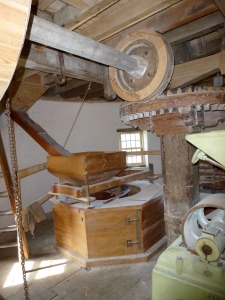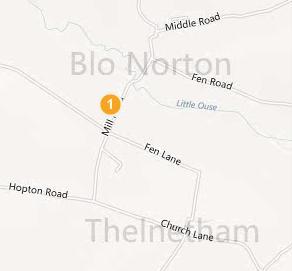Thelnetham Windmill is a tower mill built of red brick. Its walls are 2 ft (0.6m) thick at the ground floor and are tarred to keep out the rain. The inside walls are plastered and lime-washed. The tower is 20ft (6.1m) wide at its base and 12ft (3.7m) at the top, some 31ft (9.5m) above ground. The mill cap adds another 11ft (3.3m) to the overall height.
The cap is built on a heavy oak frame and runs round an iron curb on the top of the tower and is kept central by a set of six wheels. The eight bladed fantail is mounted at the rear and rotates the cap via gearing so that the sails always face into the wind.
The four patent sails have a span of 64 ft (19.5m) and each is 9 ft 6 ins. (2.9m) wide. Sails have two rows of 24 pivoting shutters which are connected by the striking gear and controlled from ground level by the striking chain. The shutters are opened or closed to suit the strength of the wind and the power required. A weight hung on the chain allows some self regulation in gusty conditions. The sails are mounted on a cast iron windshaft weighing nearly 2 tons and power is transmitted through the brake wheel which in turn drives a smaller iron wheel called a wallower. The brake wheel takes its name from a brake around its rim that is used to stop the mill.
The top or dust floor provides access to the cap and limited storage space. The second or bin floor is used to store grain prior to milling in either bins or sacks. The sack hoist is also on this floor and uses a layshaft driven by the main drive to lift sacks up from the ground floor though successive pairs of trap doors on each floor. Leather hinges ensure the doors snap shut after each sack has passed through.
The main work of the mill takes place on the first or stone floor. There are two pairs of French stone mill wheels of 4 ft 7 ins. (1.4m) and 4 ft 4 ins. (1.3m) in diameter respectively on this floor. Although the mill can operate the stones at speeds of 50 to 140 rpm, it is usually regulated to a maximum speed of 120 rpm. In a fresh breeze the sails are able drive both sets of stones with each pair producing up to 4cwt (200 kg) of flour per hour.
Flour produced on the stone floor passes down to the ground or spout floor where it is bagged for sale. The miller is able to check the quality of the flour and control the stones from this floor. The stones can be lifted out of gear with the “jack ring”. Each stone nut has a pulley on top which drives the governors to control the fineness of the flour to avoid variations in the speed of the mill affecting the quality of the flour.



